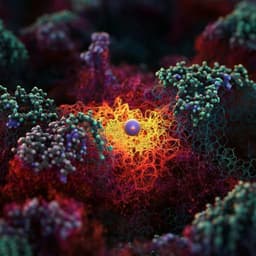
Engineering and Technology
A stable cathode-solid electrolyte composite for high-voltage, long-cycle-life solid-state sodium-ion batteries
E. A. Wu, S. Banerjee, et al.
Discover the breakthrough in rechargeable solid-state sodium-ion batteries with the innovative Na3-xY1-xZrxCl6 ion conductor. This research, conducted by Erik A. Wu and colleagues, reveals its exceptional electrochemical stability and compatibility with oxide cathodes, paving the way for safer, long-lasting energy storage solutions.
~3 min • Beginner • English
Introduction
The study addresses the challenge of developing solid electrolytes for solid-state sodium-ion batteries (SSSBs) that combine high ionic conductivity with wide electrochemical and chemical stability, particularly against high-voltage oxide cathodes. While sulfide solid electrolytes can achieve high ionic conductivity, their poor oxidative stability and interfacial compatibility with common electrodes limit long-term performance. Motivated by recent successes of lithium halide electrolytes (e.g., Li3YCl6, Li3YBr6) that show good oxidative stability and compatibility with 4 V cathodes, the authors hypothesize that sodium halide analogs can be engineered via aliovalent substitution to enhance Na+ conductivity while retaining high oxidative stability. The purpose is to design, synthesize, and characterize Na3−xY1−xZrxCl6 (NYZC) as a cathode-compatible, electrochemically stable Na+ conductor and to demonstrate its efficacy in a SSSB with a NaCrO2 cathode.
Literature Review
- Sulfide-based solid electrolytes exhibit liquid-like ionic conductivities but suffer from poor electrochemical and chemical interfacial stability with electrodes, hindering practical SSSB deployment.
- Lithium halide solid electrolytes such as Li3YCl6 and Li3YBr6 show moderate Li+ conductivities (0.5–0.7 mS cm−1) and, crucially, high oxidative stability with compatibility to 4 V LiCoO2 cathodes. Other halide conductors (Li2InCl5, Li3ScCl6+x) also demonstrate high diffusivity and processability.
- Aliovalent substitution (e.g., Zr in Li3MZrCl6) can introduce vacancies and enhance ionic conductivity to ~10−3 S/cm at room temperature.
- Electrochemical oxidative stability in solid electrolytes is largely governed by anion chemistry; halides follow the stability trend F > Cl > Br > I.
- Sodium halide analogs Na3YCl6 and Na3YBr6 have been less studied and previously showed low ionic conductivities (10−4–10−6 S/cm at 500 K), suggesting poor room-temperature performance without modification.
Methodology
Computational design and analysis:
- DFT calculations: VASP (PAW, PBE-GGA), plane-wave cutoff 520 eV. Structures and post-processing via pymatgen. Phase stability, energy above hull, interfacial reaction products, and electrochemical stability windows computed using established grand-potential and interfacial reaction frameworks.
- Dopant screening: Evaluated Ti4+, Zr4+, Hf4+, Ta5+ aliovalent substitution on Y3+ sites in Na3YCl6 to generate Na3−(2−5)xY1−xMz+Cl6 structures; assessed dopant formation energies and mixing enthalpies for the Na3YCl6–Na2ZrCl6 pseudobinary.
- Electrochemical window: Grand potential phase diagram approach to obtain oxidation/reduction limits vs. Na/Na+ for Na3−xY1−xZrxCl6 across compositions.
- AIMD: Non-spin-polarized NVT simulations with 2 fs timestep, supercells ≥10 Å minimum dimension, Γ-point sampling, 600–1000 K (and broader 500–1200 K for training snapshot generation). Diffusivities from mean square displacement via Nernst–Einstein relation.
- Machine-learning interatomic potential (ML-IAP): Moment Tensor Potential (MTP) trained on 800 AIMD snapshots (600, 800, 1000, 1200 K), 90:10 train:test. MTP cutoff 5.0 Å, levmax 14; MAE: 1 meV/atom (energies), 63.5 meV/Å (forces). NpT MD via LAMMPS on a 4×4×4 supercell (592 atoms), 2 fs timestep, ≥10 ns at 350–650 K to probe temperature-dependent diffusion and lattice dynamics. Topological analysis of diffusion channels via Zeo++ (R_in free sphere path).
Synthesis:
- Precursors: NaCl (>99%), YCl3 (99.9%), ZrCl4 (99.99%). Hand-mixed 10 min, ball milled (50 mL ZrO2 jar, eleven 10 mm Y-ZrO2 balls) for 2 h at 500 rpm. Pelletized at 370 MPa (13 mm die), sealed in quartz, heated at 500 °C for 24 h, then re-milled with eighty-eight 5 mm balls for 4 h. Zr-substituted samples prepared analogously with adjusted stoichiometry.
Characterization:
- XRD: Capillary-based lab XRD (Cu Kα, 45 kV, 50 mA, 2θ 5–90°, step 0.01°), Rietveld refinement (FullProf). Temperature-dependent XRD (5 °C/min ramp, 1 h hold). Synchrotron XRD at NSLS-II 28-ID-1.
- SEM/FIB: Cross-sectional imaging to assess pellet morphology and relative density.
- 23Na solid-state NMR: Bruker 800 MHz (18.8 T), 3.2 mm MAS at 12 kHz, quantitative acquisition with 30° pulse (0.9–0.95 μs), 30 s relaxation delay; NaCl(aq) 1 M as chemical shift reference.
- XPS: Kratos Axis Supra (Al Kα, 15 kV, <5×10−8 torr), survey (160 eV pass), regions (20 eV pass, 0.05 eV step), charge neutralizer on, calibration to C 1s; air-free transfer.
- Electrochemistry (bulk pellets): EIS with 30 mV AC, 1 MHz–1 Hz; temperature-dependent EIS from 20–100 °C (2 °C/min ramp; ≥1 h equilibration per step). DC polarization at 50 mV. Pellets pressed at 370 MPa (10 mm PEEK die), acetylene black contacts on both sides.
Battery assembly and testing:
- Model SSSB: Cathode composite (NaCrO2:SE:VGCF = 11:16:1 by weight). For SE in cathode composite: either Na3PS4 (NPS) or NYZC0.75. Electrolyte separator: 75 mg NPS pressed first at 370 MPa. Cathode composite (~12 mg) pressed onto one side; anode: excess Na–Sn (2:1) alloy (~35 mg) pressed on opposite side. Cycling via Landhe cycler. Room-temperature C/10 current density 64 μA cm−2; elevated temperature tests at 40 °C in a furnace within Ar glovebox; rates up to 1 C (640 μA cm−2). Control cells with NPS-only cathode composite. Symmetric alloy cells with Na15Sn4 (0.1 V) and Na–Sn 2:1 (0.3 V) for interface stability. Variants with reduced NPS thickness using a stainless-steel current collector support to assess rate/EIS impacts.
Key Findings
- Electrochemical stability: Na3−xY1−xZrxCl6 (NYZCx) exhibits a wide oxidative stability window with an oxidation limit ~3.8 V vs Na/Na+ across compositions; reduction limit narrows upon Zr substitution (from ~0.6 V for Na3YCl6 to ~1.5 V for NYZCx), yet remains suitable for high-voltage cathodes like NaCrO2 (2–3.6 V).
- Phase stability and structure: Zr4+ substitution is favored (low dopant formation energy) and low-cost; NYC–Na2ZrCl6 pseudobinary shows low mixing enthalpy. For x ≥ 0.875, a secondary crystalline Na2ZrCl6 phase (hexagonal P−3m1, isostructural to Na2TiF6) forms. Unit cell volume increases with x, widening Na+ diffusion channels.
- Na+ transport (simulations): AIMD shows negligible Na diffusion in Na3YCl6 at high T, but substantial increases with Zr doping. ML-IAP (MTP) reproduces AIMD diffusivities and reveals non-Arrhenius behavior with a transition near 500–550 K; low-T activation energy ~594 meV; predicted room-temperature conductivity for NYZC0.75 is 1.4 × 10−5 S cm−1.
- Na+ transport (experiments): Room-temperature ionic conductivity of Na3YCl6 is 9.5 × 10−8 S cm−1. Across 0.375 ≤ x < 1, NYZCx conductivities are 2.6–6.6 × 10−5 S cm−1; highest for NYZC0.75 at 6.6 × 10−5 S cm−1. For x ≥ 0.875, conductivity drops due to secondary NZC phase (NZC conductivity ~1.4 × 10−7 S cm−1). NYZC0.75 activation energy (low-T regime) is 663.6 meV, consistent with ML-IAP; electronic conductivity is 8.89 × 10−9 S cm−1, confirming ionic conduction.
- Mechanism: AIMD probability density maps and selective dynamics show macroscopic Na+ diffusion in NYZC0.75 requires cooperative (Y/Zr)Cl6 octahedral rotations; freezing Cl− motion suppresses Na+ diffusivity. ML-IAP analysis indicates diffusion topology changes from quasi-2D to 3D above the 500–550 K transition, correlating with increased octahedral rotation. Enhanced conductivity arises from combined effects of increased lattice volume and polyanion rotational dynamics plus Na-vacancy formation from aliovalent doping.
- Microstructure: NYZC0.75 pellets show dense morphology (relative density ~90%); NZC pellets have ~79% relative density.
- NMR: 23Na MAS NMR indicates NaCl residual/impurity content decreases with increasing Zr (x=0 to 1: 16.0%, 10.0%, 5.9%, 6.2%, 4.0%). Multiple resonances in Na3YCl6 suggest local non-stoichiometry/disorder; tentative assignment of peaks to Na0 and Na1 environments consistent with Y3+ proximity trends.
- Interfacial stability and reactions: Reaction energies with NaCrO2 are modestly negative for both NPS (−0.18 eV/atom) and NYZC0.75 (−0.14 eV/atom); temperature-dependent XRD of 1:1 mixtures with NaCrO2 shows no new phases up to 220 °C. XPS after cycling shows NPS in cathode composite oxidizes to S0 and P2Sx (and possible P–O species), whereas NYZC0.75 retains Zr–Cl and Y–Cl bonds, evidencing superior electrochemical stability with NaCrO2.
- Battery performance: Incorporating NYZC0.75 into the NaCrO2 cathode composite (with NPS separator and Na–Sn 2:1 anode) yields a first-cycle Coulombic efficiency of 97.6% at 20 °C (C/10), versus 71.9% for NPS-only cathode composite. At 40 °C, capacity is maintained when switching from C/10 to C/2 (104 to 101 mAh g−1); average CE 99.96% with 88% capacity retention after 500 cycles. At 40 °C and 1 C, the cell cycles >1000 cycles with 89.3% capacity retention (specific capacity ~78 mAh g−1), representing state-of-the-art longevity for SSSBs. NPS control at 40 °C shows worsened first-cycle CE (62.4%), indicating exacerbated oxidation.
- Practical considerations: Reducing separator thickness (halving NPS with a stainless steel support) improves rate performance per supplementary tests, highlighting optimization pathways.
Discussion
The work demonstrates that Cl-based halide frameworks, when aliovalently doped (Zr4+ for Y3+) to introduce Na vacancies and expand the lattice, can achieve significantly improved Na+ transport while preserving a high oxidative stability limit (~3.8 V vs Na/Na+). This resolves a key bottleneck in SSSBs: the incompatibility of sulfide electrolytes with high-voltage oxide cathodes. As a cathode-side solid electrolyte component, NYZC0.75 minimizes oxidative degradation at the cathode interface, effectively protecting the sulfide separator (Na3PS4) and enabling high first-cycle Coulombic efficiency and exceptional long-term cycling. Mechanistically, enhanced Na+ conduction is attributed to the cooperative rotation of (Y/Zr)Cl6 octahedra and increased diffusion channel size from lattice expansion, enabling a transition to 3D diffusion at elevated temperatures. The electrochemical data, interfacial analyses (XPS), and control comparisons (NPS-only) collectively substantiate the superior chemical/electrochemical compatibility of NYZC0.75 with NaCrO2. These findings underscore the promise of halide electrolytes as cathode-compatible components in SSSBs, offering a pathway to safer, longer-lasting sodium batteries with high-voltage oxide cathodes.
Conclusion
The study introduces Na3−xY1−xZrxCl6 (NYZC) as a new class of halide-based Na+ conductors exhibiting wide oxidative stability (~3.8 V vs Na/Na+) and markedly enhanced ionic conductivity relative to Na3YCl6, driven by aliovalent-vacancy formation, lattice expansion, and polyanion rotational dynamics. Experimentally, NYZC0.75 achieves 6.6 × 10−5 S cm−1 at room temperature with low electronic conductivity and enables SSSBs with NaCrO2 cathodes to attain high first-cycle Coulombic efficiency and outstanding cycle life (89.3% retention over >1000 cycles at 40 °C, 1 C). Interfacial analyses confirm NYZC0.75’s stability against NaCrO2, unlike Na3PS4 which undergoes oxidative decomposition. Future work should focus on increasing active material loading in the cathode composite (beyond the current ~39% NaCrO2), reducing the thickness and mass of inactive electrolyte layers, optimizing microstructure, and exploring broader halide chemistries and dopant strategies to further elevate room-temperature conductivity and compatibility across electrode chemistries.
Limitations
- The cathode composite contains only ~39% active NaCrO2, which is below practical loadings; improving energy density will require higher active mass fractions and optimized electrode architectures.
- The separator (Na3PS4) layer used in tests is relatively thick (~800 μm), contributing to rate limitations at room temperature; thinning improves performance but requires engineering advances.
- Room-temperature ionic conductivity of NYZC0.75 (order of 10−5 S cm−1) is modest compared to the best sulfide electrolytes; further enhancements are desirable for low-temperature/high-rate operation.
- Zr substitution narrows the reduction stability limit (~1.5 V vs Na/Na+), which may constrain compatibility with very low-potential anodes without protective interlayers.
- Presence of NaCl residuals/impurities and local non-stoichiometry/disorder is indicated by NMR; processing optimization may further reduce impurities.
- At high Zr content (x ≥ 0.875), formation of a secondary NZC phase decreases conductivity and relative density, indicating a compositional window for optimal performance.
Related Publications
Explore these studies to deepen your understanding of the subject.







